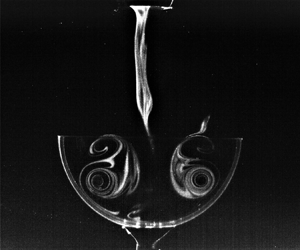Published online by Cambridge University Press: 24 July 2023

Discrete vortex rings impinging on concave hemispherical cavities were explored experimentally. Planar laser-induced fluorescence, two-dimensional particle image velocimetry and flow visualization techniques were employed. Five different ratios of vortex ring to hemisphere cavity radius ( $\gamma$) were investigated, namely,
$\gamma$) were investigated, namely,  $\gamma = 1/4,1/3,2/5,$
$\gamma = 1/4,1/3,2/5,$ $1/2, 2/3$. For
$1/2, 2/3$. For  $\gamma = 1/4,1/3, 2/5$, the geometric confinement of the primary ring due to the hemispherical cavity induced loop-like instabilities in the secondary ring, which led to head-on collision and ejection of the looped ends as they orbited the primary ring. As the hemispherical cavity decreased in diameter (increasing
$\gamma = 1/4,1/3, 2/5$, the geometric confinement of the primary ring due to the hemispherical cavity induced loop-like instabilities in the secondary ring, which led to head-on collision and ejection of the looped ends as they orbited the primary ring. As the hemispherical cavity decreased in diameter (increasing  $\gamma$), the dynamics were altered significantly due to the increased generation of vorticity along the edge of the hemisphere. For
$\gamma$), the dynamics were altered significantly due to the increased generation of vorticity along the edge of the hemisphere. For  $\gamma = 1/2$, vorticity produced at the edge/lip of the hemisphere ultimately disrupted the classical formation of a secondary vortex ring from the wall-bounded vorticity. For
$\gamma = 1/2$, vorticity produced at the edge/lip of the hemisphere ultimately disrupted the classical formation of a secondary vortex ring from the wall-bounded vorticity. For  $\gamma = 2/3$, the primary ring and hemisphere radius were close enough in size that the interaction was dominated by direct impact of the primary ring with the lip of the cavity. The primary vortex ring produced a vortex ring at the lip of the hemisphere that ultimately separated from the cavity, orbited around the primary ring, and then self-advected in the direction opposite to the primary vortex ring trajectory. A detailed investigation of the dynamics provided.
$\gamma = 2/3$, the primary ring and hemisphere radius were close enough in size that the interaction was dominated by direct impact of the primary ring with the lip of the cavity. The primary vortex ring produced a vortex ring at the lip of the hemisphere that ultimately separated from the cavity, orbited around the primary ring, and then self-advected in the direction opposite to the primary vortex ring trajectory. A detailed investigation of the dynamics provided.
Vorticity and velocity field of a vortex ring impinging on a concave hemispherical surface (γ =1/4, 1/3, and 2/5).
Planar laser induced fluorescence flow visualization of the secondary vortex ring development following collision of a primary vortex ring with a concave hemispherical surface (γ =1/4, 1/3, and 2/5).
Planar laser induced fluorescence flow visualization of the primary vortex ring impinging on a concave hemispherical surface (γ =1/4, 1/3, and 2/5).
Front view of dye flow visualization of the secondary vortex ring development following collision of a primary vortex ring with a concave hemispherical surface (γ =1/4, 1/3, and 2/5).
Top view of dye flow visualization of the secondary vortex ring development following collision of a primary vortex ring with a concave hemispherical surface (γ =1/4, 1/3, and 2/5).
Vorticity and velocity field of a vortex ring impinging on a concave hemispherical surface (γ =1/2).